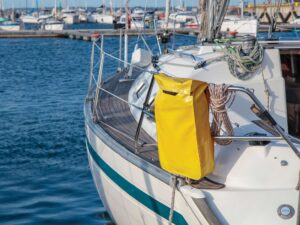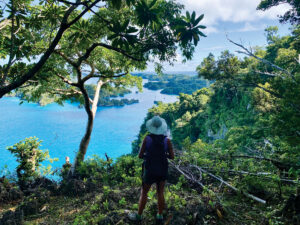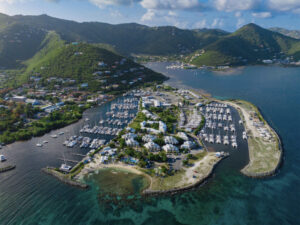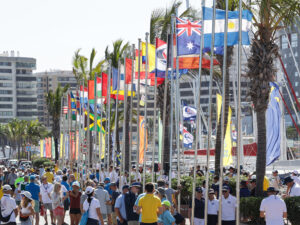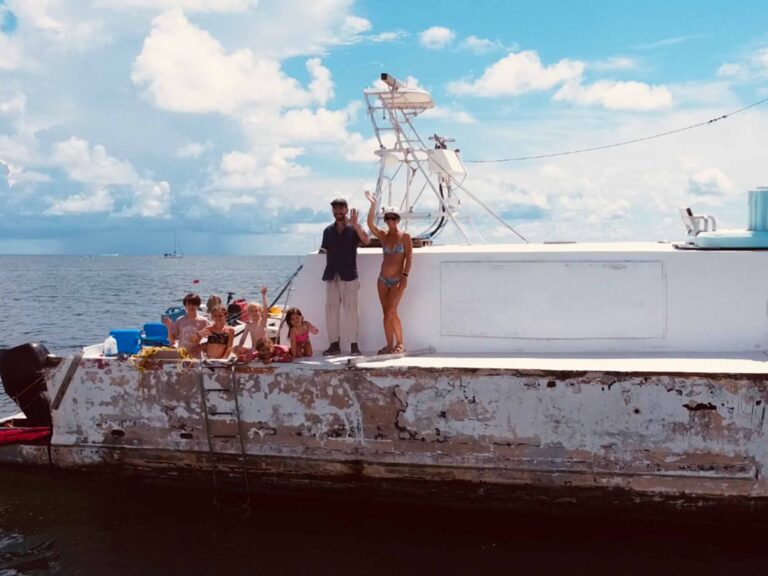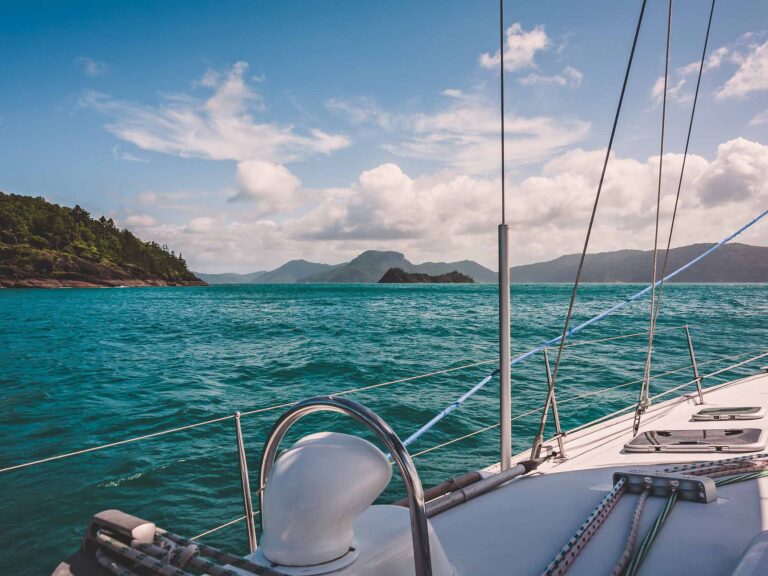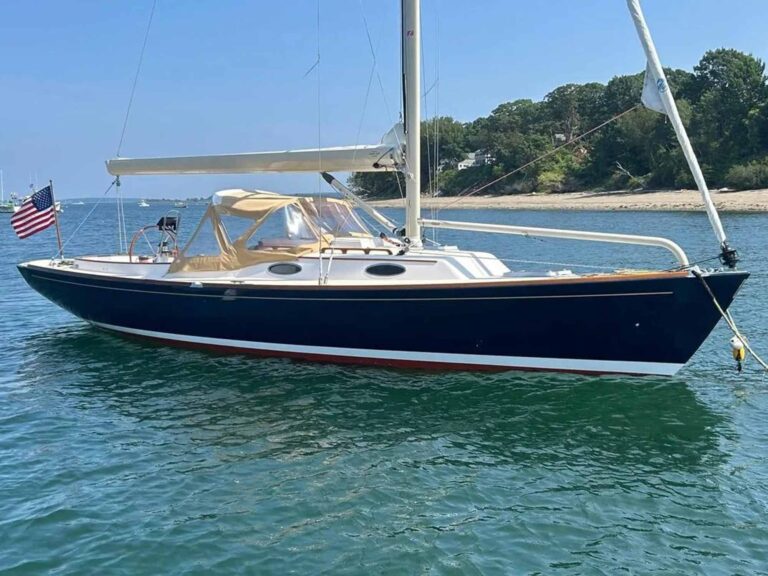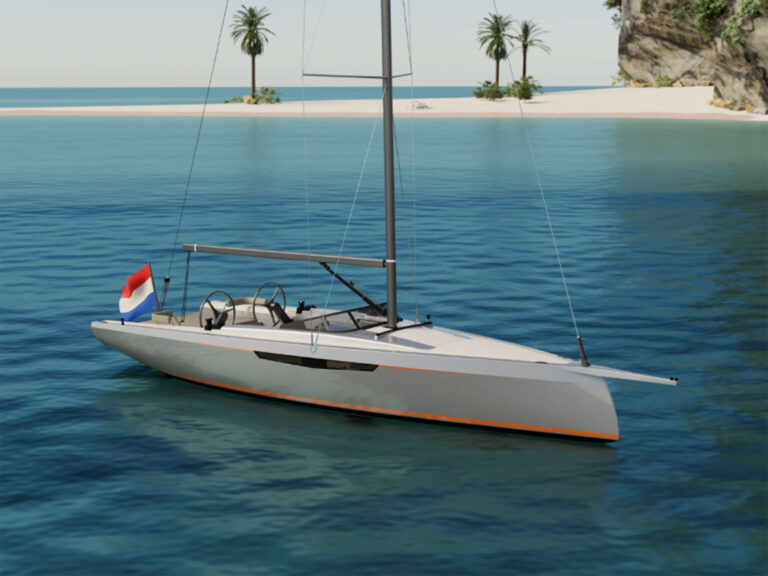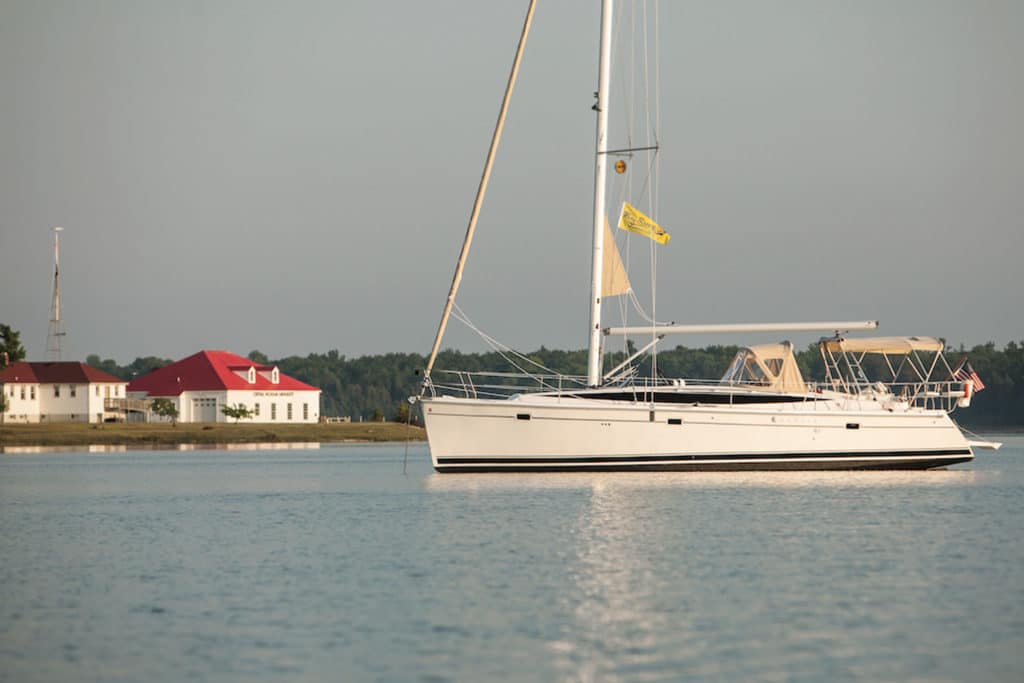
Great Lakes Sailing
As many good sailing yarns start, the fog had crept up out of nowhere, devouring our chartered 2013 Hunter 40 and making even the bow appear a distant place. It seemed all too cliché, fog engulfing the sailboat with no radar, but that was just the start of the drama. Soon it would be dark, adding to the sudden stress. Our crew, along with those on five other boats behind us in the Unsalted Island Hopping flotilla, had just entered the shipping channel in the Straits of Mackinac. Frequently, 1,000-foot lake freighters funnel through these waters at a pretty good clip. Even on sunny days smart sailors steer clear of them. It would be a long, tension-filled night until we exited the shipping channel at the south end of Gray’s Reef about 27 miles ahead. The Mackinac Bridge loomed ahead of us; at least that’s what the chart plotter was showing, and Mackinac Island was only several miles to the north, making for a good option to ditch. While our three other crewmembers were below getting some rest, the captain and I had a serious discussion about our next move. Decision time. Push on or ditch at Mackinac Island — it was that bad. Four of the boats trailing behind called in to say they had had enough and were headed to the island and a liquid dinner to settle their nerves. As safety was always our first concern, we also concluded the intelligent call was to pull the plug — the fog had trumped us. However, the one boat still behind that hadn’t turned north hailed to tell us he saw our boat on radar. He offered to be our eyes through the soup if we wanted to keep going. Suddenly the decision was easy: Press on.
Shortly thereafter, as if confirming the decision was the right one, the upper component of the fog unexpectedly lifted, while the setting sun illuminated a golden hue on the steel support towers of the Mighty Mac. However, below the bridge, fog was still a solid wall that looked like we were about to sail off the end of the world; it was the point of no return. Motoring under the bridge a short while later, our boat pushed through the curtain, popping out the other side to reveal a whole different world. There were lights on the far shore, red blinking buoys scattered in the distance and stars above, all becoming more visible by the minute. And just like that, the stress began to swirl down the drainpipe as if someone had pulled the stopper.
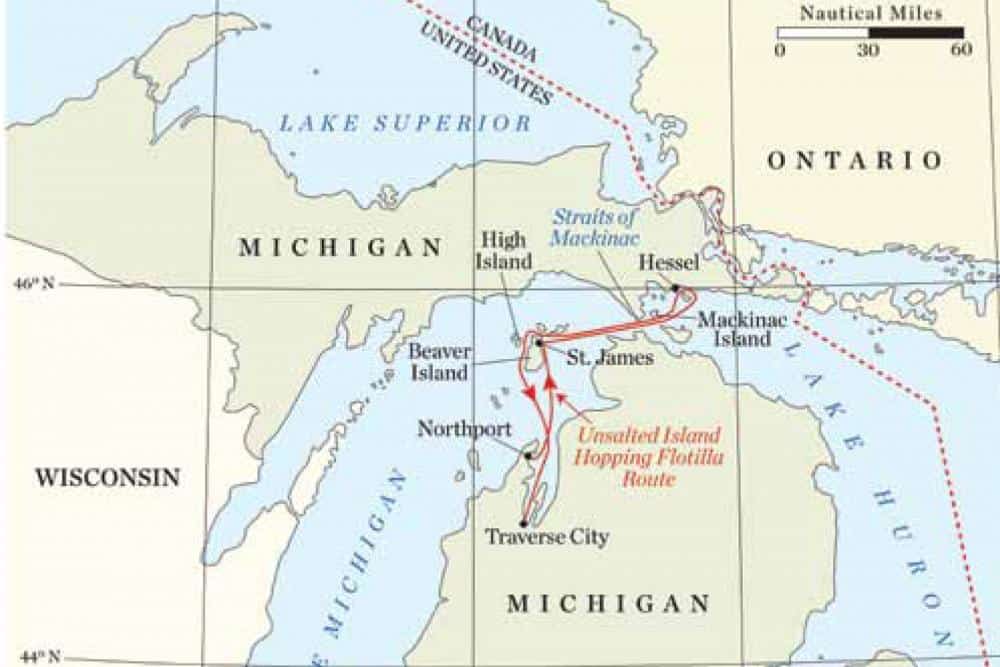
My wife, Marianne, and I had joined the Unsalted Island Hopping event earlier in the week. “How many islands can one flotilla tag in a week?” That was the challenge thrown down by Great Lakes Sailing Co. of Traverse City, Michigan. Unknown to most, there are plenty of islands on the upper Great Lakes just begging to be explored. Dave Conrad, owner of Great Lakes Sailing Co., has always enjoyed exploring the many islands north of Grand Traverse Bay; so, he wondered, why not turn it into an event? We had our marching orders and were ready to sail.
There are two distinct differences between the islands on the upper Great Lakes and those most anywhere else sailors cruise. One, the water is not salty, or as the local sailors like to say, it’s “unsalted.” It’s a nice feature. And two, there are no crowds. In fact, “crowd” isn’t even the right word, as the lack of any people at all is closer to the mark. Uninhabited also comes to mind when thinking about many of the islands. Surprisingly, as in the warmer cruising waters of the tropics, many of the upper Great Lakes islands have clear, beautiful turquoise water in the sandy shallows. Anchoring for the most part is easy, as there are no rocks to snag.
When Great Lakes Sailing Co. created the event, it wanted to try something different. Why not add new sailors who were studying for their ASA charter certifications to the mix? What a perfect way to get new sailors excited about cruising while checking off the ASA boxes that would allow them to charter boats for themselves. The Unsalted flotilla started off with four privately owned sailboats and four instructor-captained charter boats with students. The fleet was a blend of knowledgeable sailors and sailors eager to learn.
The group was an assorted bunch of enthusiastic people mainly from the Midwest, with some hailing from landlocked locales such as Bloomington, Indiana, and Lansing, Michigan. One fellow, Jerry Hardin, who hails from Dayton, Ohio, sailed his Catalina 400 from Port Clinton, on Lake Erie, to Grand Traverse Bay, Lake Michigan — roughly 500 miles solo — just to join in. Jerry — I like to think of him as “Sailor Jerry” after the rum — claimed the Unsalted Island Hopping was on his route anyway. Over the next two months his plan was to journey to Chicago and back, and the Island Hopping event was the halfway point. Stopping also gave his family the opportunity to jump onboard for the week. To strengthen the image of Midwest mariners, one night Sailor Jerry told the group about the great sea battle on Lake Eire against the British. What? The first thing I did was ask Professor Google, and sure enough, The Battle of Put-in-Bay took place during the War of 1812. It wasn’t a good day for the Brits.

Foggy conditions made for a tense time on approach to the Mackinac Bridge.
With sailing, things almost never go as they are supposed to. Maybe that’s the allure. The weather had its own ideas about the Island Hopping tour, and sent powerful Midwest freight train-like fronts our way even before we left the dock, as if to say, “You really ought to try something else, foolish sailors.” The fleet captains, whose first priority was safety, were wavering about even getting to some of the islands, and considered sending the flotilla to shoreside marinas where they wouldn’t have the worry of dragging an anchor in the middle of the night. Plans changed rapidly until we actually left. Then with a smirk on its face, the weather decided that rather than pound us with fronts we should try a little fog and no wind for a week of gray, damp motoring. Regardless, the Island Hopping was off and running, with our first target north to Beaver Island.
Beaver is a fairly large island by Great Lakes standards. It’s about 6 miles wide by 13 long, with an almost perfectly protected little harbor on the north end that’s surrounded by the only town, St. James. The basin is just big enough to anchor a handful of boats, and our little fleet fit nicely in there, anchored to the sandy bottom with plenty of swing room. The clear water made seeing the bottom easy, but still our boat nailed the only patch of weeds twice, which prevented the hook from holding.
The majority of the island is deep forest with very few homes and even fewer businesses. Remote is the best description I can think of. In 2010 there were approximately 650 year-round residents. I was curious what they did for work because with a two-hour ferry ride across buzz-saw waves, no one is making a daily commute to the mainland — except the guy driving the boat. The harbormaster in St. James said most of the jobs were in construction, building summer homes. Of course that slowed way down in 2008, so much less building is happening these days. Many residents now cater to tourism, which being that far north and in the middle of the lake, is a pastime with a small window of opportunity. This lack of diverse employment tends to keep Beaver Island a remote treasure for the adventurous visitor.
Our next island to conquer was the celebrated Mackinac Island, where cars are not permitted and fresh fudge is a major food group. Anchors came up and our fleet was off. But first, because many of the sailors in our group were training for various ASA certifications, it was time for a quick man-overboard drill while motoring.
Without warning, flotation cushions were flung over the side of each boat while students took the wheel to hone the rescuing skills they had only read about in books. Three of the boats, ours included, started making crazy lopsided circles and figure-eight patterns while trying to recover their fallen comrade, Red Cushion. I can only imagine the comments coming from the powerboaters who were eating breakfast and watched the sailboats scatter about like frightened gazelles. “Crazy sailors. I always knew they weren’t right in the head,” is probably not far off.
After hours of motoring through the fog, the fleet finally completed the passage from Beaver to Mackinac Island. On the way, the ASA couple on our boat wisely took advantage of our extensive motoring and cracked open their books to study.
Finally, after a long day of windless gray, and just before we tied up in the Mackinac marina, the fog lifted. There was still no wind, but there were things to see. The weather was having a good laugh on us, as if to say, “Look at all the great things you missed while you were in the fog.”
After a night on Mackinac, our flotilla targeted the town of Hessel, Michigan, as the next stop. If you know anything about upper Lake Huron geography, you’ll know Hessel does not even remotely resemble an island. Yet because it’s known as the gateway to Les Cheneaux Islands, with 36 islands just beyond the town, we decided it merited a visit. Besides, there were no rules for Unsalted Island Hopping; we were making things up as we went. The weather was making amends by offering wind and sunny skies for the day, allowing us to sail at last.
Les Cheneaux Islands are locally famous for wooden boats and the boathouses they are kept in. While uncommon on big waters of the Great Lakes, in the northwest corner of Lake Huron the traditional boathouse is thriving. They can survive the ravages of Great Lakes storms and the surge of winter ice because the islands here are packed tightly together, giving the feel and protection of the inland waters of the north woods. Our flotilla motored single file through the narrow channels between the islands — the channels are plenty deep and well marked with red buoys — not a problem for our shoal-draft fleet. But it was important everyone paid close attention to “returning” (as in every sailor’s favorite saying: “Red right returning”) because at some point when motoring all the way around an island you are not returning anymore; you’re leaving.
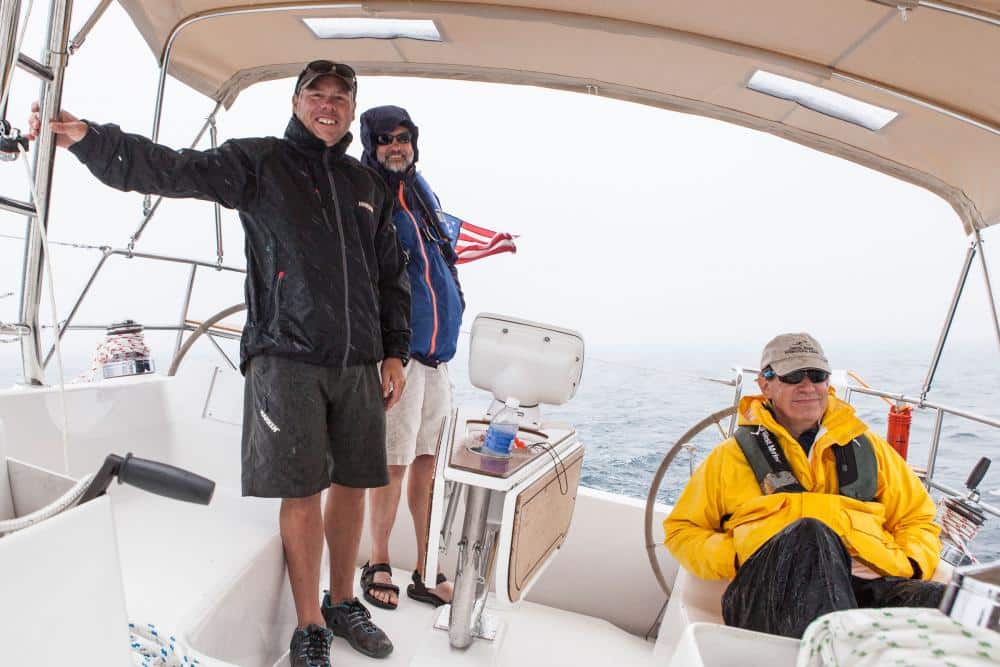
Inclement weather didn’t stop author Mike Lee, left, Paul Davis and Dick Chulski from sailing and having a good time.
After clicking off two more islands in our Hop, the final island night was to be spent anchored off High Island, due west of Beaver. But first the flotilla planned to travel through the night, past Mackinac Island by way of the Straits, under the Mighty Mac bridge, and finish off by exiting through the narrow channel of Gray’s Reef to get to High Island. No big deal; it was sunny, clear and breezy, so this had the makings of a fantastic passage. Three hours from the bridge, I went below to catch a nap before my night watch started. But when I popped up an hour later to check on things, the boat was socked in tight with damp, heavy fog. I’ve sailed in a lot of rough weather, but being blind in the fog is something I’ll always be uneasy with. We did, however, survive the shipping channels without incident, and eventually anchored off High Island and waited for the rest of the fleet to catch up.
High Island feels like it’s from a different time. Although it’s currently uninhabited, a small population called it home until 1940. The only things that currently exist on the island are thick forest and huge, nearly 200-foot-tall sand dunes on the western shore, with one or two hiking trails to get to them.
That final evening, our boat’s crew was invited over for steaks on Sailor Jerry’s Catalina. He had miscalculated their meat consumption-to-refrigeration ratio and something needed to be done. With seven of us all snuggled into the cockpit happily munching on beef, conversation turned to the excitement of motoring through the Straits of Mackinac’s foggy, dark shipping channels. That first night that we were considering bailing for the safety of Mackinac Island, it was Sailor Jerry who had said with confidence that he would guide us through the murk. But tonight, with a sheepish grin on his face, he confessed that the blip they had seen on radar was actually some other boat. They were certain of this fact because 20 minutes after our radio conversation, the blip turned and headed for safety on Mackinac Island. We had run down the highway with our eyes closed.
The weather had had its own idea about how the Unsalted Island Hopping flotilla should play out, and like all trips remembered years down the road, it’s usually the unplanned moments that make it memorable. In my mind, I had envisioned most days with sails full, making our way to three or four islands each day, and landing on them Shackleton style. Instead we had very little sailing, but still managed to step ashore on a few interesting islands, and came away with some good fog stories.
Who says you can only island hop in the tropics?
Mike Lee has been in the sailing industry for 26 years and is the author of a new e-book for young readers, The Boat Thief.
So Now What?
by Jen Brett
You’ve taken all of your certification courses and have passed your tests. You want to take your family and friends on a bareboat charter vacation, but you feel that you still could use some support. Or, you’re an experienced sailor but are interested in chartering in a new, more challenging location. If this sounds familiar, consider joining a sailing flotilla. A flotilla brings together several boats sailing independently with their own crews and a head boat with a flotilla leader who knows the area well. The flotilla leader is available to assist with navigation and to offer local cruising information, such as which marina has the best night life or which cove has the best snorkeling.
The American Sailing Association has recently launched a website called FindMyCharter.com. It is designed to be a resource for sailors of all experience levels to find a sailing vacation, from learn-to-sail opportunities to flotillas to bareboat and crewed charters. “After certification, we suggest to students that they consider joining a flotilla so they can increase their comfort and confidence levels before heading out on a bareboat charter,” says Kathy Christensen, membership manager for the ASA. Upcoming flotilla locations include Croatia, the Bahamas and the British Virgin Islands. You can read about Cruising World Deputy Editor Elaine Lembo’s recent experience on an ASA flotilla in the Pacific Northwest.

